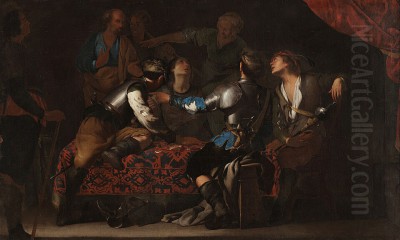
Bernardo Cavallino stands as one of the most refined and sensitive painters of the Neapolitan Baroque. Active during a vibrant and tumultuous period in Naples' artistic history, Cavallino carved a unique niche for himself with his exquisitely crafted, small-scale paintings, predominantly focusing on religious and mythological subjects. His works are celebrated for their delicate emotionality, sophisticated use of color, and masterful handling of light, setting him apart from some of the more bombastic tendencies of his contemporaries.
Early Life and Artistic Genesis in Naples
Born in Naples in 1616, Bernardo Cavallino's early life and artistic training are not extensively documented, a commonality for many artists of his era. However, it is widely accepted that he was immersed in the rich artistic environment of Naples from a young age. The city, then under Spanish rule, was a major European cultural hub, attracting artists from across Italy and beyond. This melting pot of influences created a dynamic and competitive atmosphere that undoubtedly shaped Cavallino's development.
The prevailing artistic current in Naples during Cavallino's formative years was heavily influenced by the revolutionary naturalism of Michelangelo Merisi da Caravaggio, who had worked in the city intermittently between 1606 and 1610. Caravaggio's dramatic use of chiaroscuro (strong contrasts between light and dark) and his unidealized, psychologically intense figures left an indelible mark on Neapolitan painting. Artists like Jusepe de Ribera, known as "Lo Spagnoletto," and Battistello Caracciolo became leading proponents of this Caravaggesque style.
It is believed that Cavallino received his primary training in the workshop of Massimo Stanzione, one of Naples' most prominent and successful painters. Stanzione himself had a style that blended Caravaggesque naturalism with a more classical, Bolognese-influenced elegance, perhaps derived from artists like Guido Reni or Domenichino. This tutelage would have provided Cavallino with a solid foundation in drawing, composition, and the technical aspects of painting.
The Development of a Distinctive Style
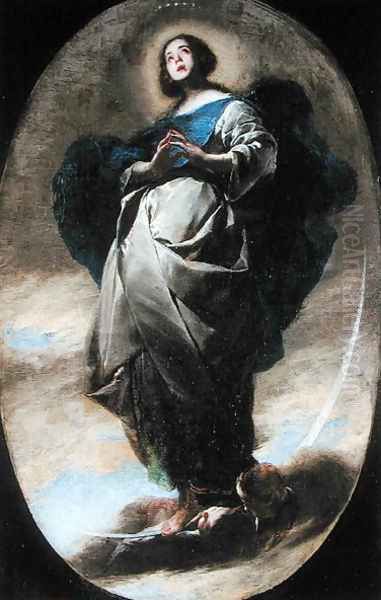
While the influence of Stanzione is discernible in Cavallino's early works, he quickly developed a highly personal and distinctive style. He moved away from the starker forms of Caravaggism, cultivating a more lyrical and poetic visual language. His figures, often slender and graceful, are imbued with a gentle melancholy and an introspective quality. Cavallino's paintings are characterized by their refined sensibility, subtle emotional nuances, and an almost jewel-like quality in their execution.
A key aspect of Cavallino's artistry is his masterful use of color and light. He favored harmonious, often muted color palettes, enlivened by carefully placed accents of brighter hues. His handling of light is particularly noteworthy; rather than the dramatic, spotlighting effects of the high Caravaggesque style, Cavallino often employed a softer, more diffused illumination that bathes his scenes in a gentle glow, creating an atmosphere of intimacy and tenderness. This approach lent itself well to the smaller scale of his canvases, which were typically intended for private patrons and devotional purposes rather than large public commissions.
The influence of other artists can also be detected in Cavallino's mature style. There is an elegance and refinement that recalls the work of Flemish masters like Anthony van Dyck, whose portraits and religious scenes were known for their aristocratic grace. Similarly, the rich textures and dynamic compositions found in some of Cavallino's works suggest an awareness of Peter Paul Rubens, though Cavallino's interpretations were always filtered through his own more delicate sensibility.
Themes and Subject Matter: Intimacy and Devotion
Cavallino's oeuvre primarily consists of small to medium-sized paintings depicting scenes from the Old and New Testaments, lives of saints, and episodes from classical mythology. These were not grand altarpieces for vast churches but rather intimate works designed for personal contemplation and the refined tastes of private collectors. This focus allowed him to explore the psychological and emotional dimensions of his subjects with great subtlety.
His religious paintings often convey a deep sense of piety and spiritual fervor, but always with a characteristic gentleness. Scenes of martyrdom, for instance, are rendered with pathos rather than overt gore, focusing on the spiritual resolve of the saints. His depictions of the Virgin Mary, such as in The Immaculate Conception (sometimes referred to as Worker Saint Mary), showcase an idealized yet human tenderness.
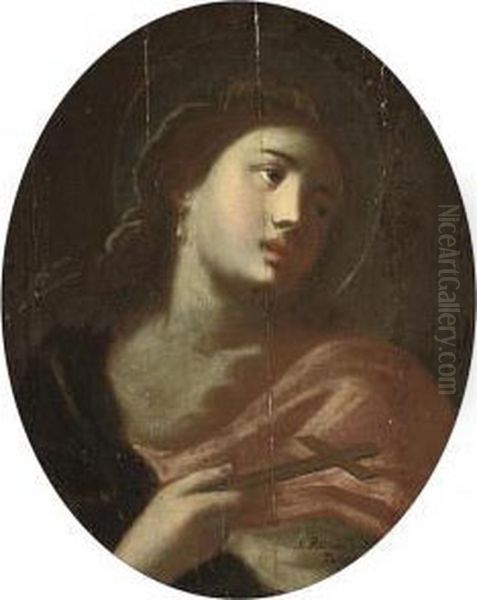
Mythological subjects provided Cavallino with opportunities to explore themes of love, tragedy, and heroism, often imbued with a lyrical, almost pastoral quality. His figures in these scenes possess a classical grace, but their emotional states are rendered with a very human sensitivity. The small scale of these works invited close viewing, allowing the observer to appreciate the delicate brushwork and the subtle interplay of expressions and gestures.
Artistic Circles and Collaborations
While detailed records of Cavallino's daily life and interactions are scarce, it is evident that he was part of Naples' vibrant artistic community. His connection with Massimo Stanzione was foundational. Stanzione's workshop was a significant training ground, and it's likely Cavallino interacted with other pupils and assistants there, such as Francesco Guarino and Onofrio Palumbo, with whom Stanzione sometimes collaborated on larger projects.
A particularly intriguing aspect of Cavallino's career is his potential association with Artemisia Gentileschi. Gentileschi, one of the most formidable female painters of the Baroque era and a follower of Caravaggio (and daughter of Orazio Gentileschi), was active in Naples for a significant period, from 1630 until her death in the mid-1650s. There are stylistic affinities between certain works by Cavallino and Gentileschi, particularly in their shared interest in dramatic narratives and expressive figures.
Art historians have noted potential collaborations or mutual influences. For example, some scholars suggest Cavallino might have assisted Gentileschi on certain commissions or that they shared models or studio practices. Works like Gentileschi's Triumph of Galatea have been discussed in terms of possible contributions from Cavallino, and paintings such as David and Saul, once attributed to Cavallino, have been re-evaluated with Gentileschi in mind. The exact nature of their relationship remains a subject of scholarly discussion, but the artistic dialogue between them seems plausible given their contemporaneous activity and shared artistic environment in Naples.
Masterpieces and Notable Works
Despite a relatively short career, tragically cut short by the plague, Bernardo Cavallino produced a body of work that includes several masterpieces. Among his most celebrated paintings is The Ecstasy of Saint Cecilia (c. 1645), now housed in the Museo di Capodimonte in Naples. This work exemplifies Cavallino's mature style, depicting the patron saint of music in a moment of divine rapture, surrounded by angels. The composition is dynamic, Cecilia's pose is elegant and expressive, and the use of light and color creates an ethereal, otherworldly atmosphere. The delicate rendering of fabrics and the tender expressions of the figures are characteristic of Cavallino's refined artistry.
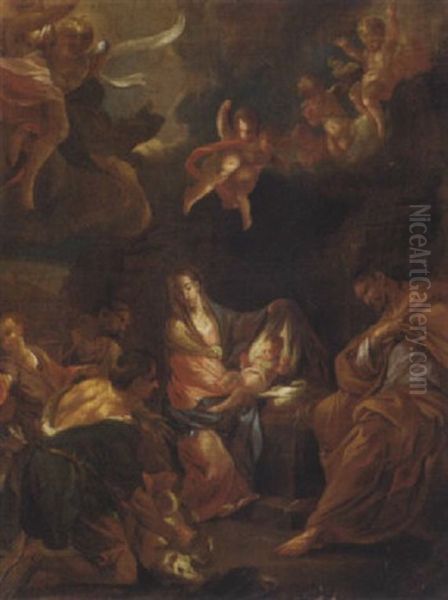
Another significant work is The Singer (La Cantatrice), also in the Museo di Capodimonte. This painting, likely from the 1630s, showcases Cavallino's skill in capturing a sense of immediacy and charm. The subject, a young woman playing a stringed instrument, is rendered with a lively naturalism, her gaze engaging the viewer directly. The rich textures of her costume and the subtle play of light on her face demonstrate Cavallino's technical virtuosity.
The Martyrdom of Saint Bartholomew, a version of which was recently acquired by the National Gallery in London (c. 1640-1645), displays Cavallino's ability to handle dramatic subjects with both intensity and restraint. While the scene depicts a violent act, Cavallino focuses on the saint's stoic acceptance and spiritual transcendence, avoiding gratuitous brutality. The composition is carefully balanced, and the figures are imbued with a palpable emotional weight.
Other important works include Saint Peter and Cornelius, which illustrates Cavallino's narrative skill and his ability to convey complex interactions between figures. David and Solomon and Judith with the Head of Holofernes (a version in the Nationalmuseum, Stockholm, c. 1650) further demonstrate his engagement with popular biblical themes, interpreted through his unique lens of sensitivity and elegance. His depiction of Saint Catherine of Alexandria is another example of his ability to portray female saints with both grace and strength.
The Enigma of Cavallino: Scarcity of Documentation
One of the challenges for art historians studying Bernardo Cavallino is the relative scarcity of biographical information and signed works. Of the approximately eighty paintings currently attributed to him, fewer than ten bear his signature or a definitive date. This has made the precise chronology of his oeuvre and the full extent of his artistic activities somewhat difficult to reconstruct.
His background and specific training, beyond the likely apprenticeship with Stanzione, remain somewhat mysterious. This lack of documentation contributes to the enigmatic aura surrounding the artist. However, the consistent quality and distinctive style of his attributed works provide a strong basis for understanding his artistic personality and his significant contribution to Neapolitan painting. The intimate scale of most of his works suggests a career primarily sustained by private patronage rather than large-scale public or ecclesiastical commissions, which might also explain the fewer contemporary records.
Later Years and Premature Death
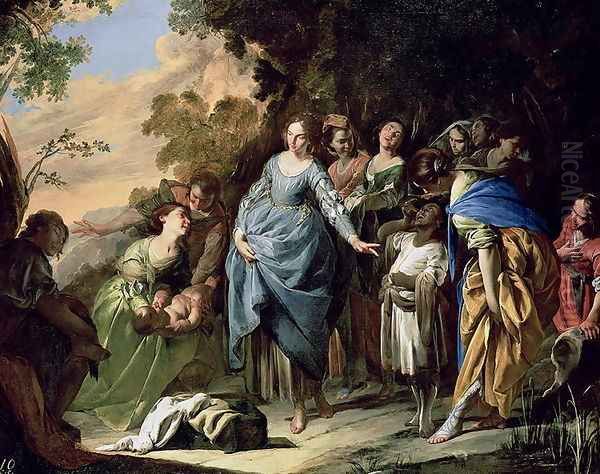
Bernardo Cavallino's promising career was tragically cut short. He is believed to have died in Naples in 1656, a victim of the devastating plague epidemic that swept through the city that year. This plague had a catastrophic impact on Naples, decimating its population and claiming the lives of many artists, including Massimo Stanzione and Onofrio Palumbo. Cavallino was only around forty years old at the time of his death, leaving behind a body of work that, while substantial for its quality, hints at an even greater potential that remained unfulfilled.
The loss of such a talented and individual voice was a significant blow to the Neapolitan art scene. The artistic landscape of Naples was profoundly altered by the plague, with many established figures gone and new talents emerging in the aftermath.
Legacy and Rediscovery
For a considerable period after his death, Bernardo Cavallino was a somewhat overlooked figure in the broader narrative of Italian Baroque art. While his works were appreciated by connoisseurs, he did not achieve the widespread fame of some of his more flamboyant contemporaries. However, the 20th century saw a significant reassessment and rediscovery of his art. Scholars began to recognize the unique quality of his work, its poetic sensibility, and its importance within the context of Neapolitan painting.
Exhibitions dedicated to Neapolitan Baroque art, and specifically to Cavallino, have helped to bring his achievements to a wider audience. His paintings are now prized possessions in major museums around the world, including the Museo di Capodimonte in Naples, the Brera Art Gallery in Milan, the National Gallery in London, the Nationalmuseum in Stockholm, and various collections in the United States.
The 1985 exhibition "Civiltà del Seicento a Napoli" (Civilization of the Seventeenth Century in Naples) was a landmark event that helped to solidify Cavallino's reputation. More recent acquisitions and focused exhibitions, such as the display of The Martyrdom of Saint Bartholomew at the National Gallery, London, in 2023, continue to highlight his unique contribution. His works are admired for their technical brilliance, their emotional depth, and their distinctive blend of naturalism and lyrical elegance.
Conclusion: A Painter of Refined Sensibility
Bernardo Cavallino remains a captivating figure in the history of art. In the bustling, often dramatic world of Neapolitan Baroque painting, he cultivated a style of remarkable refinement and intimacy. His small-scale masterpieces, characterized by their delicate beauty, subtle emotionality, and masterful handling of light and color, offer a unique window into the spiritual and aesthetic concerns of his time.
Though his life was short and details of his biography remain elusive, his artistic legacy endures. Cavallino's ability to infuse traditional religious and mythological subjects with a profound sense of human feeling and poetic grace distinguishes him as one of the most original and appealing painters of his generation. He was a master of quiet drama, a poet in paint, whose works continue to resonate with viewers for their timeless elegance and tender humanity. His art stands as a testament to the rich diversity of the Neapolitan Baroque and secures his place as a luminous talent within it.